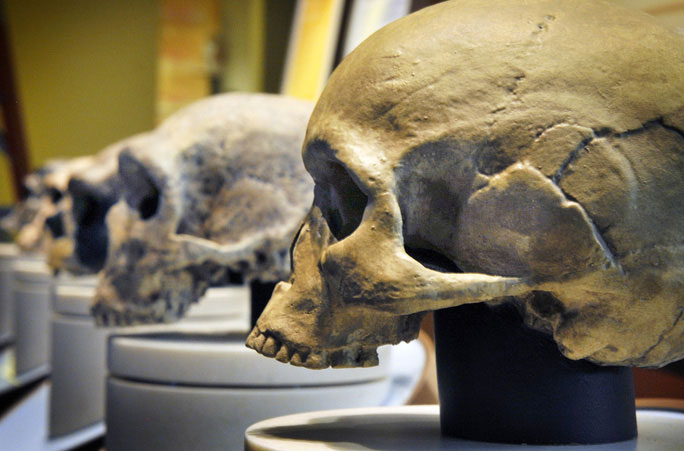Data from 985 human fossils and several modern specimens indicate that during the Pleistocene epoch, the human brain reached its maximum size but surprisingly shrank in the later stages of the Holocene epoch.
This research finding challenges the long-standing hypothesis that the human brain has consistently increased in size and volume throughout the evolutionary process.
Researchers from Dartmouth College in the United States, led by Dr. Jeremy DeSilva, examined the evolutionary history of the human brain by analyzing 985 human fossil specimens from various periods and comparing them with modern humans.

Skulls of different human species that have existed on Earth since the Pleistocene epoch, with sizes generally increasing over time to accommodate larger brains, though there are exceptions – (Photo: Bill O’Leary/The Washington Post).
According to EurekAlert, they identified a period when the human brain significantly increased in size, approximately 2.1 to 1.5 million years ago, spanning from the late Pliocene epoch to the early Pleistocene epoch of the Quaternary period (the epoch we currently belong to).
Pleistocene Epoch (around 1.8 million years ago to 11,700 years ago) was also a period when humans made significant evolutionary advancements in tool use and social organization, exemplified by the development of a populous and intelligent species within the genus Homo – Homo erectus, which had a much larger brain than its predecessors.
However, according to a paper published in Frontiers in Ecology and Evolution, about 3,000 years ago, the average brain size of humans began to decrease. The authors suggest that this change was due to adaptations to social living. As society evolved towards more selective task assignments for individuals, the brain adapted to function more efficiently – becoming smaller rather than cumbersome and all-encompassing.
Some of the burdens that the brains of individuals had to bear in previous generations could be “offloaded” thanks to reliance on and utilization of collective intelligence – the conveniences we strive to achieve for an easier life. Consequently, the brain requires less energy to operate and evolves to shrink in size. This helps the body conserve a significant amount of energy since the brain is the most energy-consuming organ in the human body.
Moreover, a larger brain does not equate to higher intelligence. Evidence lies in the case of an ancient human species – the Neanderthals, who belong to the same genus as Homo sapiens and went extinct around 30,000 years ago, yet had significantly larger brains than ours. Despite possessing many skills and developments comparable to Homo sapiens, they were assessed to have poorer adaptability to adversity and social organization, which contributed to their extinction as Earth’s environment changed unfavorably.


















































